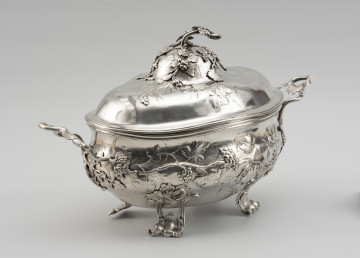
Tureen
1762 — 1770
National Museum in Szczecin
Part of the collection: Craft and industry products of Szczecin
Dated 1899, decorated with an engraved floral motif, a silver pyx from the collection of the National Museum in Szczecin has no attributed authorship. However, we do know that it was the property of the new Szczecin Protestant community founded in the same year, for which a sanctuary was built a few years later at the then Am Berliner Tor (now pl. Zwycięstwa). The neo-Gothic church, dedicated to Jan Bugenhagen, co-founder and representative of the Evangelical Lutheran Church in Pomerania, was built in brick on a rectangular plan between 1906 and 1909. The project was designed by the Berlin architect Jürgen Krӧger (1856-1928). At the end of the Second World War, the building was partly destroyed. In 1947 it was taken over by the Polish garrison ministry and in 1948, after the major damage had been repaired, it was given the patronage of St Adalbert as a Roman Catholic church. These types of receptacles serve as church paraphernalia of various denominations and are used to distribute communion during the liturgy and to hold the consecrated bread, which are small hosts baked from flour and water that, after consecration, become Holy Communion. They most often assume the form of a lavishly decorated and sometimes gemstone-embellished chalice with a lid or a round box and are called ciborium. Smaller cans, called pyxis, are used to transport a small amount of sacramental bread. Even today, it is still the rule that these should be made of precious metals, which are durable and do not corrode and therefore do not contaminate the host. Care is taken to ensure that they are gilded at least on the inside. In contrast to the belief held in Catholic doctrine that bread and wine are actually transformed into the body and blood of Christ during the Eucharist (transubstantiation), Protestant denominations such as Protestantism recognise the sacramental wafers as the body of Christ only during the celebration of the Lord's Supper (consubstantiation), and therefore their Eucharistic forms are not stored. Małgorzata Peszko
Author / creator
Object type
liturgical objects, religious object, can (container)
Technique
bending, granulation, grawerowanie
Material
gold, silver
Origin / acquisition method
purchase
Creation time / dating
Creation / finding place
Owner
Muzeum Narodowe w Szczecinie
Identification number
Location / status

1762 — 1770
National Museum in Szczecin

1680 — 1700
National Museum in Szczecin

1677
National Museum in Szczecin
DISCOVER this TOPIC
Museum of King Jan III's Palace at Wilanów
DISCOVER this PATH
Educational path